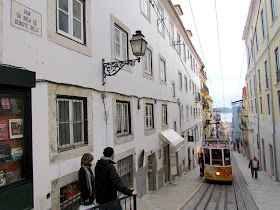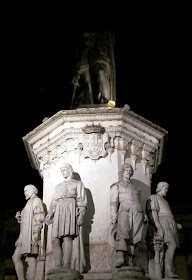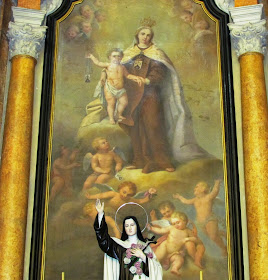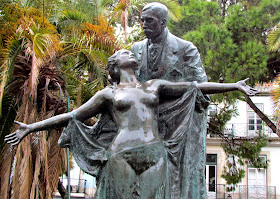LARGO DO CALHARIZ
ASCENSOR DA BICA
This elevator was inaugurated on 28 June 1892 and its route is known as the most typical of the city. Route:Rua de São Paulo (Rua Duarte Belo) - Largo de Calhariz.
Timetable:
Monday to Saturday: 7:00 a.m. to 8:55 p.m.
Sunday and holidays: 9:00 a.m. to 8:55 p.m.
(**) At the end of this page, an optional extension of route
RUA DO LORETO
 |
| GOOD MORNING; BUENOS DIAS; BONJOUR |
A - PRAÇA LUÍS DE CAMÕES
This small square is the transition zone between Chiado and Bairro Alto.
In its center is a monumental statue of 16th century epic poet Luis de Camões standing on a pedestal with other smaller statues of classical Portuguese authors. Behind it is a historical kiosk serving traditional Portuguese refreshments.
It faces Largo do Chiado, where there are two Baroque churches: Loreto (also known as "of the Italians") and Encarnação. Here is also Lisbon's best-known café, A Brasileira, a meeting place of several generations of intellectuals and artists. In front is a statue of poet Fernando Pessoa sitting in a chair, recalling the days when he used to write at this cafe.
A CALÇADA PORTUGUESA ( 3 NEXT PICTURES
TO GET THERE:
Metro: GREEN AND BLUE LINES ( Baixa-Chiado METRO STATION.
Carris: TRAM 28 (STOP: Pç. Luís Camões) | BUS 758 ( STOP : Pç. Luís Camões).
CHIADO
Chiado is the name of a square and its surrounding area in the city of Lisbon, in Portugal. The Chiado is located between the neighbourhoods of Bairro Alto and Baixa Pombalina.
The Chiado is a traditional shopping area that mixes old and modern commercial establishments, concentrated specially in the Carmo and Garrett Streets. Locals as well as tourists visit the Chiado to buy books, garments, pottery as well as to have a cup of coffee. The most famous café of Chiado is "A Brasileira", famous for having had poet Fernando Pessoa among its customers. The Chiado is also an important cultural area, with several museums and theaters.
B - LORETO CHURCH ( Igreja dos Italianos )
 |
| 1909 |
A community of about 1200 Italians (mostly Venetian and Genoese merchants) was responsible for the building of this church in 1528. It was greatly damaged by fire in 1651 and once again in the 1755 earthquake. Its present appearance dates from a reconstruction in 1785 but it's still known as the "Church of the Italians."
It has twelve side chapels in Italian marble with statues of the twelve apostles, and the façade includes sculptures by Barromini, one of the leading architects of Roman Baroque.
Other highlights inside include a monumental 18th-century organ and the 18th-century painting on the ceiling showing the Virgin of Loreto.
GETTING THERE:
Metro: Baixa-Chiado
Rua da Misericórdia
C - ESPAÇO CHIADO
 |
| ESPAÇO CHIADO- RUA DA MISERICÓRDIA 14 |
D - RESTAURANT "TAVARES RICO" ( very expensive )
E - CHURCH OF ENCARNAÇÃO
F - PALACE " BARÃO DE QUINTELA "
Located in the charismatic Lisbon neighbourhood of Chiado and built between 1777 and 1788, the Barão de Quintela e Conde de Farrobo Palace is a striking example of the architectural style known as Pombaline, which dominated Lisbon’s reconstruction following the earthquake of 1755. Extensively remodelled and improved by generations of owners, the Palace was enriched with decorative plasterwork, oil paintings and frescos by Portuguese Neoclassical artists António Manuel da Fonseca and Cyrillo Volkmar Machado.
Official residence of General Junot during the Napoleonic invasions, the scene of lavish social gatherings and the creation of the Portuguese Republican Party in the early 20th century, once a museum, antiques salon and home to the world’s largest dedicated Camões library, the history of the Palace mirrors that of the city itself. Awarded the status of classified heritage building of public interest in 1938, the Palace was the headquarters of IADE, one of Portugal’s leading design schools, upon its establishment in 1969 and has since become the school’s cultural headquarters.
The result of a partnership with IADE, experimentadesign takes on the curatorial direction of Palácio Quintela from, June 16, 2010 till June 16, 2011, with a regular programme. The common goal of experimentadesign and IADE is to position the Palace as a thriving hub in design and architecture. Diversified, accessible and stimulating, the programme aims to attract and engage more participants in the discussion and exploration around these disciplines and other contemporary creative practices. In addition to exhibitions, the venue will also host master classes, debates, launches, performances and lectures. Open to independent cultural agents, new collaborations and transdisciplinary projects, Palácio Quintela is a creative hub for experimentation and innovation, inviting dialogue and sharing. From Lisbon, reaching out to the world.
from experimentaldesign.pt)
(experimentadesign +351 210 993 045 T
+351 210 963 866 F
info@experimentadesign.pt
Cabinet du général Junot, commandant des troupes de Napoléon dans les guerres napoléoniennes.
G - MONUMENT TO EÇA DE QUEIRÓZ
H - TILES FACTORY "SANTANA"
Rua Alecrim 95 - Chiado
Tel: 213 422 537
Calçada da Boa Hora, 96 - Belém
Tel: 213 638 292
http://www.santanna.com.pt/
Making beautiful tiles by hand since 1741, this is where to go for something original for your home.
The fact that they're handmade means that no two pieces are exactly alike and they're not exactly cheap.
You can find many of them at the shop in Chiado, or see the artisans at work at the factory in Belém which also has a shop.
It also makes reproductions from the 17th and 18th centuries and ships them abroad.
(**) OPTIONAL EXTENSION

LARGO DE SÃO PAULO
C - SÃO PAULO CHURCH
Porque razão não se instalam, no interior das igrejas, um dispositivo de iluminação, que funciona durante um certo período de tempo, com a introdução de uma moeda? Existe em todos os países e é um bom investimento. As igrejas, como é o caso desta, não mostram a beleza dos seus interiores. E porque razão, em algumas outras igrejas ( ex: Santa Catarina, Mártires) não são permitidas fotografias? Depende do grau de estupidez de quem? Do pároco? Se a falta de inteligência pagasse imposto, há muito que a crise tinha sido debelada.
AROUND CHURCH OF SÃO PAULO







.JPG)






















.JPG)


.JPG)

.JPG)






























.JPG)






















.jpg)

.JPG)
















.jpg)

.JPG)




























































































.JPG)


.JPG)
.JPG)
.JPG)
.JPG)
.JPG)
.JPG)
.JPG)
















































.JPG)
































